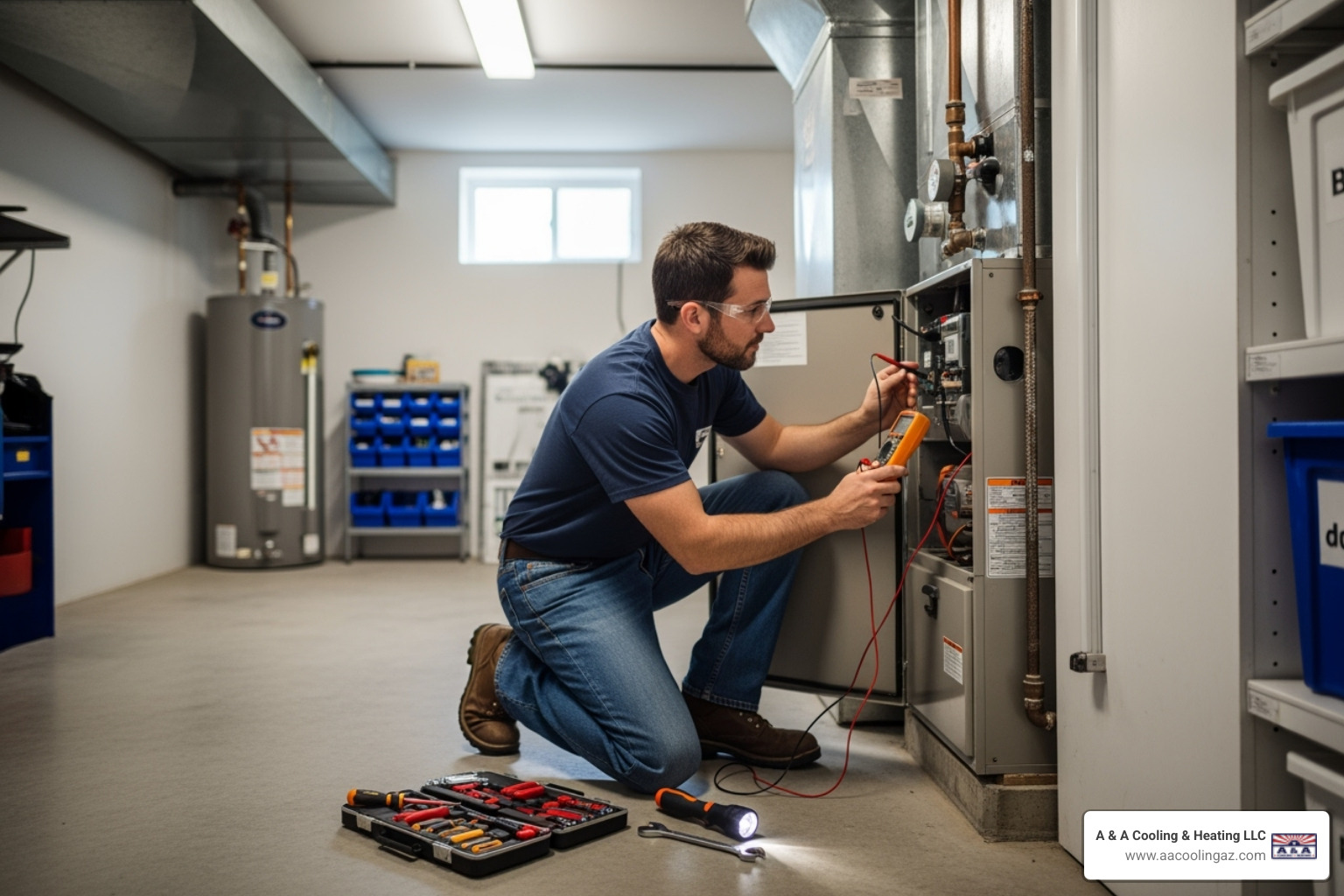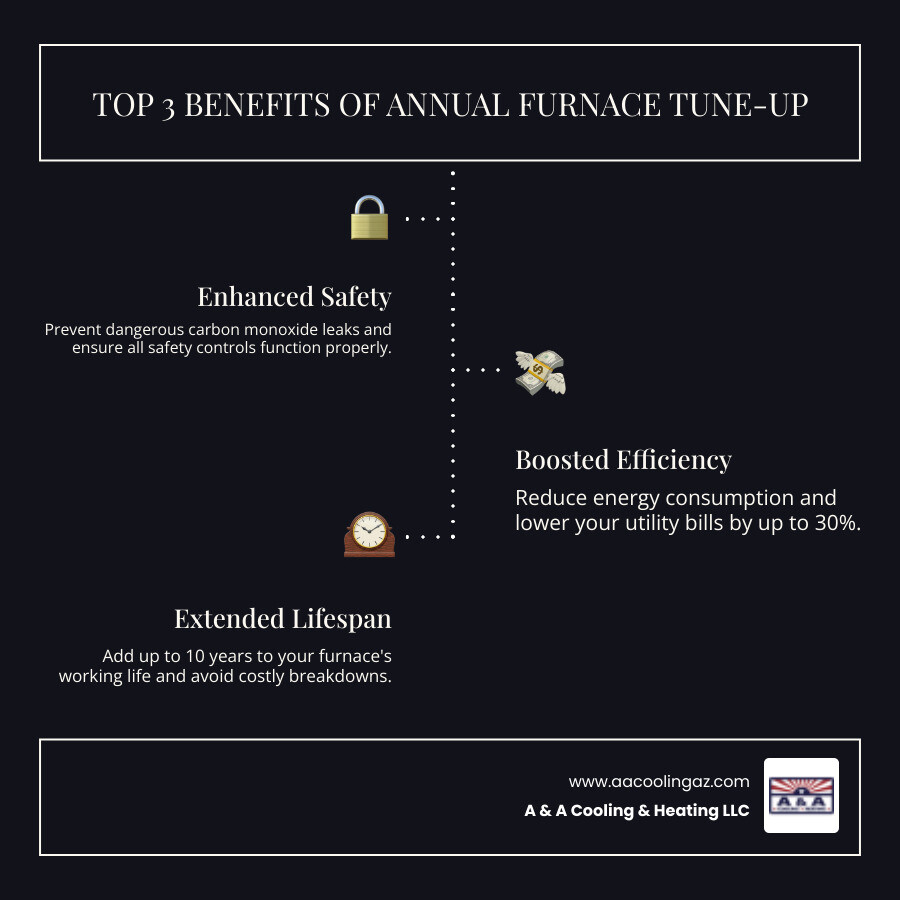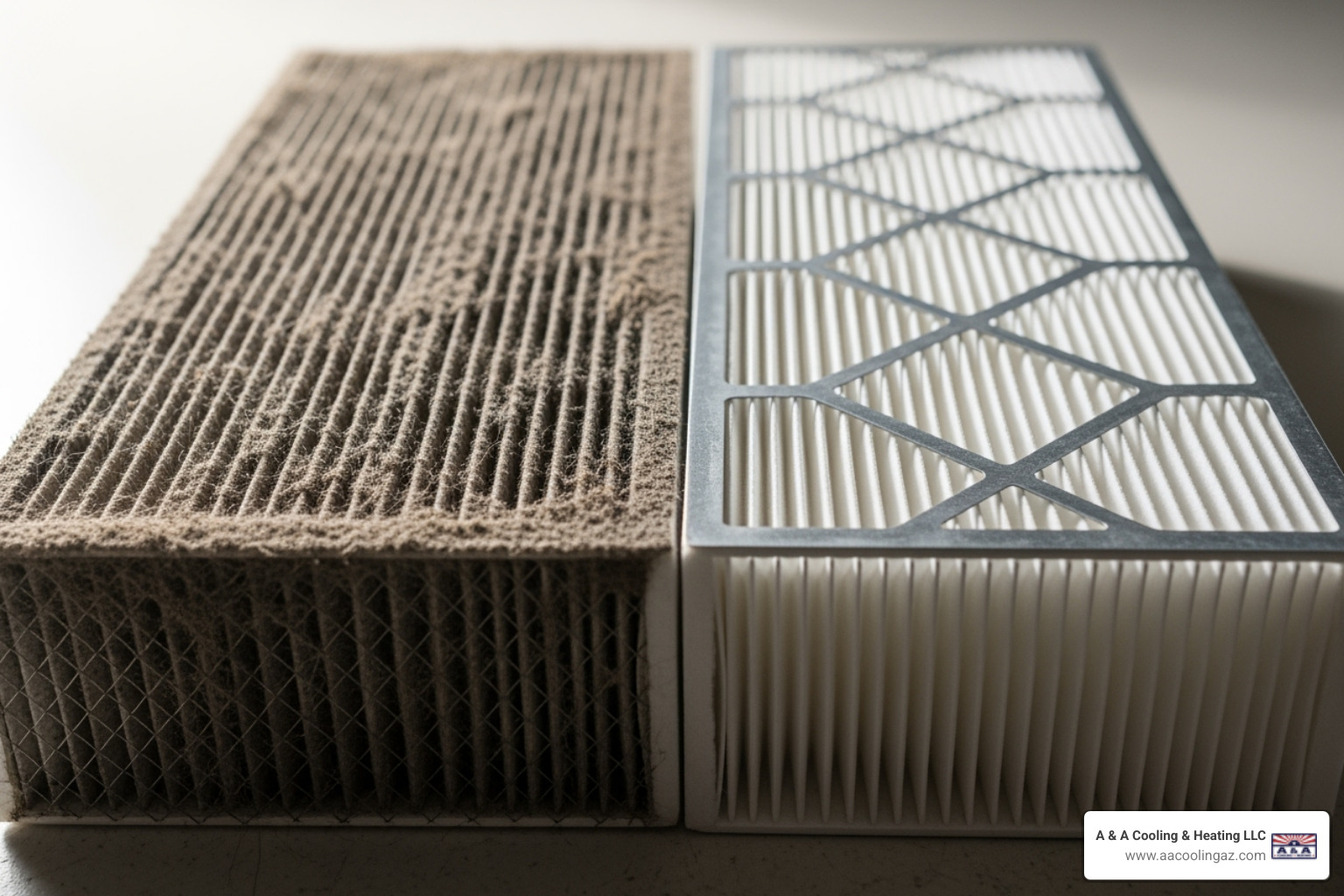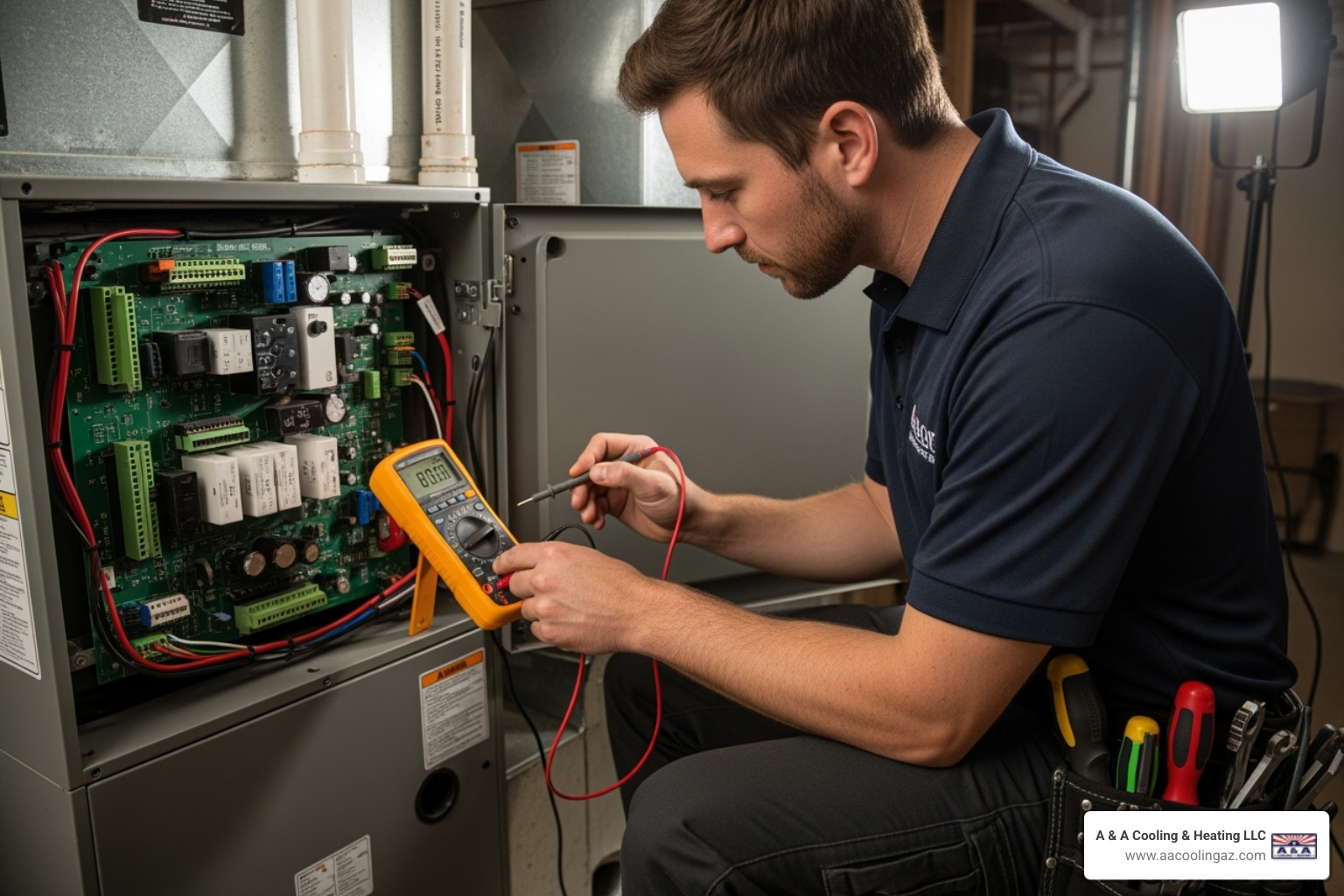Don't Skip a Beat: Get Your Furnace Inspected and Tuned Up Today

Why Your Furnace Deserves a Yearly Checkup
Furnace inspection service is a comprehensive professional maintenance visit where a trained HVAC technician examines, cleans, and tests your heating system to ensure it operates safely and efficiently. Here's what you need to know:
Quick Answer: What is a Furnace Inspection Service?
- What it includes: Safety checks (carbon monoxide, gas leaks), cleaning key components (burners, blower, flame sensor), testing performance (airflow, thermostat calibration), and identifying potential issues
- Why it matters: Prevents dangerous carbon monoxide leaks, reduces energy bills by up to 30%, extends your furnace's lifespan by up to 10 years, and keeps your warranty valid
- When to schedule: Annually in early fall, before the heating season begins
- How long it takes: Typically 1-2 hours for a complete inspection
Living in Apache Junction, you know how critical a reliable heating system is during those cold desert nights. Just like you wouldn't skip oil changes for your car, your furnace needs regular attention to keep your family safe and comfortable.
Think of a furnace inspection as a proactive health checkup for your home. A professional technician catches small issues before they become expensive emergencies. They'll verify that dangerous gases aren't leaking into your home, ensure your system isn't wasting energy, and confirm that all safety controls work properly.
The research is clear: regular maintenance reduces repair needs by up to 70% and can add a full decade to your furnace's working life. Even better, annual inspections are often required to maintain your manufacturer's warranty—meaning skipping them could cost you thousands if a major component fails.
Whether you're hearing strange noises, noticing uneven heating, or simply haven't had your system checked in over a year, a furnace inspection service addresses these concerns before they leave you shivering in the middle of winter.

Telltale Signs Your Furnace Needs an Inspection
Your furnace works quietly in the background most of the time, keeping your Apache Junction home comfortable through those chilly desert nights. But when something's not quite right, it usually sends you signals—sometimes subtle, sometimes impossible to ignore.
Learning to recognize these warning signs early can save you from an emergency breakdown on the coldest night of the year. More importantly, it can keep your family safe from potential hazards like carbon monoxide leaks.
Unusual noises are often the first clue that something's amiss. Furnaces make some sound during normal operation, but they shouldn't sound like a rock concert or a haunted house. Banging or clanking typically means loose or broken components inside your system. Sometimes it points to a problem with the ignition—gas can build up and create small explosions inside the furnace, which is as alarming as it sounds. Screeching or squealing usually indicates worn motor bearings or failing belts. Left unchecked, those worn bearings can lead to complete motor failure. A persistent rattling sound often means parts have come loose and are vibrating against each other.
Inconsistent heating is another red flag worth investigating. If some rooms feel like the Sahara while others are downright chilly, or if your furnace runs constantly but never quite gets your home comfortable, you've got a problem. This could stem from a clogged air filter restricting airflow, a malfunctioning blower motor that can't push warm air effectively, or issues with your ductwork like leaks or blockages.
Keep an eye on your utility bills too. If they suddenly spike without explanation, your furnace is likely working overtime to compensate for an underlying issue. That inefficiency costs you money every month until a furnace inspection service identifies and fixes the root cause.
Frequent cycling—when your furnace turns on and off repeatedly in short bursts—is hard on your system. This "short cycling" wears down internal components faster and wastes energy. Common culprits include a malfunctioning thermostat, airflow restrictions, or internal furnace problems that need professional diagnosis.
Strange smells deserve immediate attention. A slight burning dust smell when you first fire up your furnace for the season? That's normal. But persistent or unusual odors are warning signs. A rotten egg smell indicates a gas leak and requires immediate evacuation and professional help. A burnt smell might be dust burning off, but it could also signal dangerous electrical wiring issues. Musty odors suggest mold or mildew growing somewhere in your system.
Don't ignore visible wear and tear either. Rust, cracks, or corrosion on furnace components compromise both efficiency and safety. Visible leaks around your unit often point to problems with the condensate drain line.
Finally, if your carbon monoxide detector goes off, treat it as the emergency it is. Evacuate immediately and call for help. A malfunctioning furnace can produce this odorless, colorless, deadly gas—which is exactly why regular inspections matter so much.
5 quick signs your furnace is calling for help:
- Unusual noises like banging, screeching, or rattling
- Inconsistent temperatures or weak airflow from vents
- Unexplained spike in your heating bills
- Furnace turning on and off frequently
- Strange smells or visible rust and corrosion

What to Expect from a Professional Furnace Inspection Service
A furnace inspection service is a preventative check-up, unlike a repair that fixes an existing problem. During an inspection, we check your system’s health to catch small issues before they become big headaches, ensuring everything runs safely and efficiently. Most appointments take just 1 to 2 hours. Our technicians perform a comprehensive multi-point check using specialized tools and training to spot problems that aren't visible to the untrained eye.

Safety First: Critical Component Checks
Your family's safety is our top priority. Our inspection focuses on detecting serious hazards that require professional equipment.
The heat exchanger inspection is the most critical safety check we perform. This component separates the combustion gases from the air that circulates through your home. Even a tiny crack can allow deadly carbon monoxide to seep into your living spaces. We carefully examine the heat exchanger for any signs of cracks, rust, or deterioration.
We also test for carbon monoxide. Using specialized detection equipment, we measure carbon monoxide levels around your furnace. This colorless, odorless gas is impossible for you to detect on your own, which is why professional testing is so important.
For gas furnaces, gas line integrity checks are non-negotiable. We inspect every connection, the gas valve assembly, and all components for potential leaks or corrosion. According to the Gas Furnace Inspection Checklist, the gas shut-off valve must be accessible, located in the same room as the furnace, within 6 feet of the unit, and positioned upstream of the union. We verify all these requirements during our inspection.
Electrical connections might not seem as dramatic as gas leaks, but loose or corroded wiring can cause fires or system failures. We inspect and tighten all connections, checking everything from the main control board to the transformer and other electrical components.
Your furnace also has several safety controls—built-in shut-off devices designed to prevent overheating or dangerous operation. We test each one to confirm they're working correctly and will actually shut down the system if something goes wrong.
Finally, we inspect your flue and venting system to ensure exhaust gases are safely directed out of your home. We check for proper installation, blockages, corrosion, and signs of improper condensation. A compromised venting system can allow dangerous gases to back up into your living spaces.
Cleaning for Peak Performance
A dirty furnace works much harder than a clean one, leading to higher energy bills and a shorter system lifespan. Dust, dirt, and debris accumulate on components over time, creating resistance that forces your furnace to strain.
We start with the blower components—the motor, fan blades, and housing. You'd be surprised how much pet hair, dust, and debris can collect here, restricting the airflow that carries warm air throughout your home. A clean blower moves air effortlessly, which means better heating and lower energy consumption.
For gas furnaces, we clean and adjust the burners to ensure a clean, efficient flame. A properly burning flame should be blue. If you've noticed yellow or orange flames, that's often a sign of dirty burners or fuel supply issues—both problems we address during cleaning.
The flame sensor is a small component that detects whether the burner has actually ignited. When it gets coated with carbon buildup, your furnace might short cycle or fail to ignite altogether. We clean it carefully with fine abrasive material to restore proper function.
We also clean the furnace cabinet interior, removing accumulated dust and debris. This isn't just about efficiency—it's about your indoor air quality. Everything inside your furnace cabinet eventually affects the air circulating through your home.
For high-efficiency condensing furnaces, we inspect and clear the condensate drain line. When this line clogs, water can back up and cause leaks or even shut down your entire system.
Testing and Calibration
Once everything is clean and inspected, we move into the testing and calibration phase. Here, we fine-tune your system to operate as the manufacturer intended.
Thermostat calibration ensures your system responds accurately to temperature settings. A thermostat that's even a few degrees off can cause your furnace to run too often or not enough, wasting energy and leaving you uncomfortable.
We measure airflow to confirm it falls within the optimal range for your system. Poor airflow creates uneven heating, reduces efficiency, and can even damage your furnace over time. If we find airflow problems, we can often correct them by adjusting fan speeds or addressing ductwork issues.
We also verify the startup cycle by watching your furnace go through its complete ignition and heating sequence. This lets us spot any hesitation, unusual behavior, or safety concerns during operation.
Finally, we test the limit switches—safety devices that prevent your furnace from overheating. We confirm they trip at the correct temperatures, ensuring your system will shut down safely if something goes wrong.
These procedures follow best practices for standard furnace tune-ups recommended by energy efficiency experts, giving you confidence that your furnace is operating at peak safety and efficiency.
The Long-Term Payoffs of Annual Furnace Maintenance
Think of your furnace like a trusted friend who's always there when you need them most. You wouldn't ignore a friend's needs, right? The same goes for your heating system. Investing in a regular furnace inspection service isn't just about avoiding an inconvenient breakdown—it's about securing comfort, safety, and real savings for years to come.

Key Benefits of a Furnace Inspection Service
When you schedule an annual furnace inspection, you're making a decision that pays dividends in multiple ways. Let's talk about what really matters.
Safety comes first, always. Our comprehensive inspections check for gas leaks, carbon monoxide leaks, and faulty electrical components that could put your family at risk. The Canadian Fire Safety Association, insurance companies, and local gas providers all recommend annual safety inspections for good reason. Preventing even one carbon monoxide leak makes the service worth every penny. This invisible, odorless gas is truly dangerous, and a cracked heat exchanger or improper venting can allow it to seep into your living spaces.
Your wallet will thank you. A well-maintained furnace uses significantly less energy. Over time, dust and debris accumulate, and components naturally wear down, forcing your system to work overtime just to keep you warm. A clean, properly tuned furnace delivers the same cozy heat while consuming less fuel or electricity. Those savings show up every month on your utility bills, and they really add up over a heating season.
Your furnace will stick around longer. A furnace represents a significant investment in your home's comfort—typically lasting 15 to 20 years with proper care. Annual inspections catch minor issues before they snowball into major problems that can cut your system's life short. Regular maintenance can extend your heating system's lifespan by up to 10 years. That's potentially a full decade before you need to think about replacement costs.
Unexpected breakdowns become rare. Regular maintenance reduces the likelihood of needing emergency repairs by up to 70%. When a technician spots a worn belt or a failing component during a routine visit, they can replace it on your schedule, not when you're already shivering at midnight.
Your warranty stays protected. Here's something many homeowners overlook: most furnace manufacturers actually require annual maintenance by a qualified HVAC technician. They often won't cover damage caused by improper or neglected maintenance. An annual furnace inspection service provides the necessary documentation to keep your warranty valid. Without it, you could be on the hook for expensive repairs that would otherwise be covered.
The air you breathe gets cleaner. During an inspection, we thoroughly clean components like the blower and check your filters. This process removes accumulated dust, pollen, and other allergens from your heating system before they can circulate through your home. If anyone in your family has allergies or respiratory sensitivities, this benefit alone can make a noticeable difference in daily comfort.
Skipping regular inspections creates a domino effect. Small issues worsen, leading to unexpected and costly breakdowns. Your energy bills rise as the system struggles inefficiently. Most seriously, unchecked gas leaks or a cracked heat exchanger can create carbon monoxide hazards. Add a potentially voided warranty and a system that wears out years earlier, and the cost of neglecting your furnace becomes clear.
DIY Maintenance to Complement Your Furnace Inspection Service
While a professional furnace inspection service handles the technical and safety-critical work, there are several simple tasks you can do between our visits to keep your system happy. Think of these as the everyday care that helps your furnace stay healthy between its annual checkups.
The air filter is your best friend. This is hands-down the most important task you can do yourself. A dirty filter chokes your system, restricting airflow and making your furnace work much harder than it should. We recommend checking your filter monthly and replacing or cleaning it every one to three months. If you have pets or anyone with allergies, you might need to change it even more frequently. It takes just a minute, and the difference in efficiency is remarkable.
Keep the air flowing freely. Take a quick walk through your home and check that no furniture, rugs, or storage boxes are blocking your return air vents or supply registers. Your system needs proper airflow to distribute heat evenly and operate efficiently. It's a simple fix that makes a real difference.
Give your furnace some breathing room. The area around your furnace should stay clear of clutter, especially anything flammable. This ensures proper airflow for combustion and makes it easy for technicians to access the system when needed. A tidy furnace room is a safer furnace room.
Don't forget the thermostat. If your thermostat runs on batteries, swap them out annually before the heating season begins. It's one of those small tasks that prevents a frustrating surprise on a cold morning.
Here's how your tasks and professional service work together:
| DIY Furnace Tasks | Professional Furnace Inspection Tasks |
|---|---|
| Change/clean air filters | Inspect heat exchanger for cracks |
| Keep vents and registers clear | Test for carbon monoxide leaks |
| Clear area around furnace | Check gas line integrity and connections |
| Check/replace thermostat batteries | Clean and adjust burners and flame sensor |
| Listen for unusual noises | Inspect and tighten electrical connections |
| Monitor utility bills | Test safety controls (limit switches, rollout switches) |
| Measure airflow and temperature rise | |
| Calibrate thermostat | |
| Inspect flue and venting system | |
| Clean blower motor, fan blades, and housing | |
| Inspect plenums for mold, insulation, and debris | |
| Check condensate drain line for clogs (high-efficiency units) |
Your DIY efforts between professional visits help maximize your system's performance and efficiency. But the technical work—checking for carbon monoxide, inspecting the heat exchanger, testing safety controls—requires specialized tools and training that only a qualified technician can provide. Together, these efforts keep your furnace running reliably year after year.
Frequently Asked Questions about Furnace Inspections
We understand you might have questions about keeping your furnace in top shape. Here are some of the most common concerns we hear from homeowners in Apache Junction:
How often should I get my furnace inspected?
Once a year, every year. This is what your furnace needs to stay safe and efficient, and it's recommended by most manufacturers, safety associations, and gas providers.
The best time to schedule your annual furnace inspection service is early fall, before you need to turn on the heat. This helps you get ahead of the rush and allows us to fix any minor issues before you depend on your furnace daily. That said, if you miss the fall window, an inspection in winter is still far better than skipping it altogether.
How does an inspection maintain my furnace's warranty?
This detail, often buried in the fine print, can save you thousands: most furnace manufacturers require proof of annual professional maintenance to honor their warranty. It's right there in the warranty documentation that came with your system.
Why do they care? Because they know that regular maintenance prevents most of the problems that cause furnaces to fail. If you haven't been maintaining your system and a major component breaks down, they'll often deny the warranty claim. And furnace repairs – especially major ones like replacing a heat exchanger or control board – can be extremely expensive.
When you schedule a professional furnace inspection service with a qualified technician, you get documentation that proves your system has been properly maintained. We keep records of every inspection, what we found, and what we did. This paperwork is your insurance policy, protecting your actual warranty and your wallet.
Think of the annual inspection fee as a small investment that protects a much larger one. Without it, you're essentially gambling that nothing will go wrong – and if it does, you're on your own.
What happens if I never get my furnace inspected?
Skipping your annual furnace inspection service is like ignoring a car's check engine light. It might seem fine for a while, but eventually, a problem will arise.
The safety risks alone should give you pause. An uninspected furnace can develop cracks in the heat exchanger or problems with gas connections that lead to carbon monoxide leaks. This odorless, colorless gas is incredibly dangerous – it's called the "silent killer" for a reason. Every year, hundreds of people die from carbon monoxide poisoning, and thousands more end up in the emergency room. A simple annual inspection catches these issues before they become life-threatening.
Beyond safety, neglected furnaces are money pits. They lose efficiency gradually, so you might not notice that your utility bills are creeping up month after month. Dust accumulates, parts wear down, and suddenly your furnace is working twice as hard to produce the same amount of heat. That wasted energy adds up to real money on your utility bills.
Then there's the breakdown factor. Minor issues that would take minutes to fix during a routine inspection turn into major failures when they're ignored. And furnaces have a talent for breaking down at the worst possible times – usually on the coldest night of the year when every HVAC company is booked solid with emergencies. Emergency repairs cost more, take longer to schedule, and leave you shivering in the meantime.
As we mentioned earlier, skipping maintenance also voids your manufacturer's warranty, leaving you to pay out of pocket for repairs that should have been covered. And ultimately, a neglected furnace simply won't last as long. Regular maintenance can add up to a decade to your system's lifespan. Without it, you'll be shopping for a new furnace years earlier than necessary – a much bigger expense than annual tune-ups.
The bottom line? Annual inspections aren't an expense – they're an investment in your safety, comfort, and long-term savings.
Conclusion: Ensure Your Comfort and Safety This Winter
Your furnace works hard behind the scenes, keeping your Apache Junction home cozy when those cold desert nights roll in. It's easy to take it for granted—until something goes wrong. But here's the good news: you don't have to wait for a breakdown to take action.
Everything we've covered today points to one simple truth: a professional furnace inspection service is one of the smartest investments you can make for your home. It's not just about avoiding the inconvenience of a cold house in January. It's about protecting your family from carbon monoxide poisoning. It's about keeping your energy bills in check instead of watching them climb month after month. And it's about making sure your heating system lasts as long as possible, giving you reliable comfort for years to come.
Proactive care means peace of mind. When you schedule your annual inspection, you're taking control. You're catching small problems before they become expensive emergencies. You're ensuring that every component is clean, calibrated, and working safely. You're documenting the maintenance that keeps your manufacturer's warranty valid. Most importantly, you're making sure your family stays warm and safe all winter long.
Of course, not all HVAC companies are created equal. When you're choosing someone to care for your heating system, look for NATE-certified technicians who have the training and expertise to do the job right. Experience matters too—especially local experience. A technician who understands the unique climate challenges of Apache Junction and the surrounding area will provide better service than someone just passing through.
That's where we come in. At A & A Cooling & Heating LLC, we've been serving Apache Junction families since 1976. That's nearly five decades of keeping homes comfortable, safe, and energy-efficient. We don't believe in one-size-fits-all solutions. We take the time to understand your specific needs and tailor our services accordingly. Whether it's a comprehensive furnace inspection service, an urgent repair, or ongoing maintenance through our Cool Club plan, we're here for you.
Don't wait until you're shivering under blankets, wondering why your furnace picked the coldest night of the year to quit. Take the proactive step today.
Schedule your furnace inspection in Apache Junction, AZ and give yourself the gift of warmth, safety, and peace of mind this winter.



















